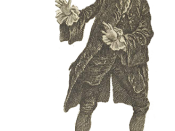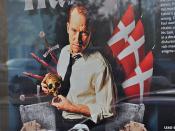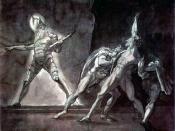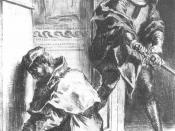It was Wolfgang Clemen who used the phrase "image cluster" to designate Shakespeare's use of repeated patterns of imagery functioning within individual plays as a sort of key signature. Recent articles in The Explicator have focused on such images as the wheel (Andrews) and the pearl (Ault); other critics have focused on the imagery of the mirror (Henry) and the rat (Berstein). Although the problem of Hamlet's sexuality has been in the forefront since such Freudian classics as the one by Jones, oddly little has been said about another complex of images, which recur throughout the course of the play, concerning conception, gestation, and birth.
The first such instance comes in Hamlet's famous warning to Polonius to keep Ophelia out of the sun: "If the sun breeds maggots in a dead dog," Hamlet warns, Ophelia had best "not walk in the sun. Conception is a blessing, but as your daughter may conceive, friend, look to't" (2.2.181-85).
Conception as "breeding" and as fantasy are linked in this disgusting analogy. Similar linkages occur when Horatio notes that the mad Ophelia's speech "may strew I Dangerous conjectures in ill-breeding minds" (4.5.15) and when Claudius remarks, after spying on Hamlet and Ophelia, "There's something in his soul / O'er which his melancholy sits on brood, / And I do doubt the hatch and the disclose / Will be some danger" (3.1.164-67). The analogy here yokes Hamlet's melancholy musing to a hen brooding upon eggs which, when hatched, will "disclose" some danger to the state: gestation = brooding = thinking; eggs = thoughts; hatching = deeds born of thought.
Gertrude returns to the image of a bird brooding in its nest, and to the linkage of hatching and disclosing, when she predicts that silent calm will follow Hamlet's "fit" in Ophelia's grave: "Anon, as patient as the female dove / When that her golden couplets are disclosed / His silence will sit drooping" (5.1.273- 75). The image here is of the dove hatching ("disclosing") a pair of fledglings ("golden couplets"), and it suggests an allegory of poetic creation (among other things), for where else has Hamlet hatched golden couplets to disclose the guilt of the King if not in the "speech of some dozen or sixteen lines" that he tells the Players he will "set down and insert" in "The Murder of Gonzago," a play composed entirely of couplets (2.2.526)? These examples focus on the connection between "breeding" and "brooding," encoded in our language by the two meanings of the word conception (as in the joke about the man who, when asked what the difference between men and women might be, responded, "I can't conceive!"). The related notion of pregnancy is also frequent in the play: "How pregnant sometimes his replies are," Polonius says of the cryptic remarks Hamlet makes during his madness; these remarks, Polonius continues, have a "happiness that often madness hits on, which reason and sanity could not so prosperously be delivered of" (2.2.206-09). Once again, the concept here is of language bearing meanings that are "delivered" in speech, as children are delivered by midwives. (Horatio will also use the word deliver at the end of the play as a metaphor for meaningful speech.) Later in the play the analogy shifts from pregnancies of meaning to pregnancies of action: Expressing his disdain for courtiers who, unlike Horatio, win advancement through flattery, Hamlet says "No, let the candied tongue lick absurd pomp, / And crook the pregnant hinges of the knee" (2.2.58). Such obsequious courtesies become "pregnant" with advancement when inseminated by royal patronage. Earlier in the play, Hamlet had berated himself for his long procrastination by saying he was "Like John-a-dreams, unpregnant of my cause" (2.2.553), which is of course to kill Claudius. This analogy brings us close to the heart of Hamlet's mystery. It suggests that, in a moment of frustration, he sees himself as having not been made pregnant by the coming of the Ghost in act one (the genesis of the "cause" in this speech).
This complex matrix of perinatal associations colors our understanding of Hamlet's attack on his mother in her bedroom, when he accuses her of having committed "such a deed I As from the body of contraction plucks / The very soul" (3.4.46--49). The "deed" that Hamlet accuses Gertrude of having committed is incest with his father's brother Claudius. But the word deed also refers to the marriage contract. Hence the play on the word contraction, which denotes the marriage deed, but with perinatal connotations. Beyond the Oedipal complex is the imagery of the birth trauma: Hamlet has returned to the place not only of his conception but also of his birth, his mother's bed. The images of conception, birth, and death merge into a single cluster. As Stephen Booth notes, "contracted, 'betrothed,' 'drawn together,' can specify the nature of the union by means of its potential for suggesting 'vulva'--a potential that Shakespeare was ready to hear in any word containing con, or cun, or a similar sound" (231). Hence the use of the phrase "body of contraction" in Hamlet's attack on his mother evokes labor and delivery as much as it does the spasms of breeding.
Up to this point in the play, Hamlet has remained "unpregnant" of his "cause," which reaches maturity, after a properly lengthy period of gestation and brooding, when he assassinates Claudius in the last act. After the death of all the major characters during that scene, Horatio absents himself from the felicity of death to draw his breath in the pain of this world and tell Hamlet's story (5.2.35-36): "So shall you hear," Horatio says to Fortinbras, "Of carnal, bloody, and unnatural acts.... All this can I / Truly deliver" (5.2.369). He "delivers" his story like the fairy's midwife, in attendance at the birth of those deeds that render Hamlet no longer "unpregnant" of his cause, just after those bodily contractions that have plucked Hamlet's soul from his body, replacing a "rhapsody of words" with "silence." Having conceived the cause of revenge in the first act, he has now hatched those deeds upon which he has long been brooding, and Horatio is ready to deliver his story. Perhaps he will do so with the kind of "golden couplets" that Gertrude had imagined Hamlet as hatching, and which the Players had used to disclose the guilt of the King in "The Mousetrap." The image cluster of breeding, brooding, and birthing operates as a metaphor of the political, psychological, and aesthetic processes of conception, action, and poetic composition.





